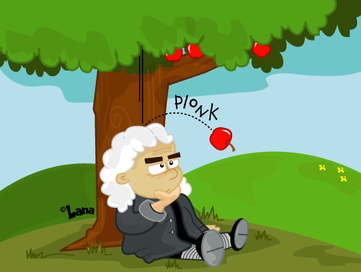|
Home >> AP Physics I >> Gravitation and Orbits
|

Gravity is the crowning achievement of classical mechanics. That the physics of the science lab actually works in space is astounding. This was when we first really appreciated the universal nature of the so-called laws of physics. Even now, over 400 years after Newton, NASA regularly uses the classical description of gravity and mechanics to pilot its spacecraft. Newton's law of gravity describes how gravity behaves pretty well, although not perfectly, and most importantly, it does not explain HOW gravity works. This is still a bit of a mystery. Einstein went further with his theory of General Relativity, but we are far from fully understanding gravity.
The story goes that Newton was sitting under his apple tree and looking at the Moon wondering... He then had the realisation that the force that kept the Moon orbiting the Earth was the same basic force that brought an apple to the Earth - presumably not his head! Some quick calculations brought him to the famous inverse-square law of gravitational attraction. The other laws of motion did the rest.
To get a very close approximation for planetary orbital motion we simply equate this law of gravity with the centripetal equation that describes circular motion and hey presto, the empirically derived Kepler's Laws pop out as a consequence.
The slight errors with reality are due to the non-circular nature of planetary orbits, but for most bodies this is negligible. One body that is in orbit around another, orbits the centre of mass of the system, rather than the centre of that object. This leads to slightly elliptical orbits and tidal forces within the objects. Also, one planets orbit is ever so slightly affected by the other planets. None of these perturbations are required for college level physics courses....
The story goes that Newton was sitting under his apple tree and looking at the Moon wondering... He then had the realisation that the force that kept the Moon orbiting the Earth was the same basic force that brought an apple to the Earth - presumably not his head! Some quick calculations brought him to the famous inverse-square law of gravitational attraction. The other laws of motion did the rest.
To get a very close approximation for planetary orbital motion we simply equate this law of gravity with the centripetal equation that describes circular motion and hey presto, the empirically derived Kepler's Laws pop out as a consequence.
The slight errors with reality are due to the non-circular nature of planetary orbits, but for most bodies this is negligible. One body that is in orbit around another, orbits the centre of mass of the system, rather than the centre of that object. This leads to slightly elliptical orbits and tidal forces within the objects. Also, one planets orbit is ever so slightly affected by the other planets. None of these perturbations are required for college level physics courses....
- 4 - 6% exam weighting for the multiple choice questions
- 7 - 9 lessons